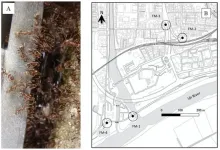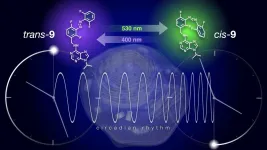(Press-News.org) Researchers from the Danish psychiatry research-project iPSYCH have contributed to identify 33 new genetic variants which, as it turns out, play a role in bipolar disorder. To achieve this, they have examined DNA profiles from 413,000 people.
A number of scientific working groups are currently attempting to identify the genetic architecture underlying heritable and severe psychiatric disorders such as schizophrenia, depression and bipolar disorder.
One of these working groups is iPSYCH, Denmark's largest research project focusing on psychiatric disorders. Together with international colleagues, they have recently examined the genetic risk factors behind bipolar disorder. The research groups have examined DNA profiles from a total of 413,000 people of European descent.
These comprise 42,000 patients with bipolar disorder together with 371,000 individuals without the disorder. By comparing the results from these two groups, the researchers have succeeded in identifying 33 genetic variants which, as it turns out, play a role in the risk of developing bipolar disorder.
More knowledge about the disorder
This means that the number of mapped genetic variants - genetic risk factors - behind bipolar disorder has more than doubled, explains one of the Danish participants in the project, Associate Professor Thomas Damm Als from the Department of Biomedicine at Aarhus University:
"In the international collaboration that we're part of and which is focused on mapping genetic risk factors behind bipolar disorder, we've carried out three studies. Before we began the third study, we had knowledge of 31 risk variants - so this is a really significant increase in our knowledge of the genetic architecture of the disease."
The results have been published in the scientific journal Nature Genetics.
The 413,000 DNA profiles that the research group has examined stem from a total of 57 European health databases - with around 7,000 profiles from iPSYCH, the Lundbeck Foundation's Initiative for Integrated Psychiatric Research.
But what exactly are the researchers examining when they map out genetic variants in connection with a psychiatric disorder?
"On a general level we're looking for certain patterns in the prevalence of large pieces of DNA with several variants. Over time a whole 'library' of these genetic variants, which can appear in different places in the genome - our DNA that is - has been built up," says Thomas Damm Als.
Ideas for new treatment
By examining DNA from people who have a particular disease - and then comparing the results with DNA from people who are not affected by it - it is therefore possible to utilise the 'library' to see whether certain genetic variants are especially present in connection with the disease.
"This was how we found the 33 variants," says Thomas Damm Als: "But before we got to this point, we had to take all 413,000 DNA samples and look for variants at eight million places in the genome. It was a huge analysis, and it was only possible because more than two hundred researchers participated in the work."
However, the genetic variants do not provide the complete explanation of how a person develops bipolar disorder.
"They are various contributory factors, environmental factors, however, also play a role - and a similar 'cocktail' of hereditary and environmental factors are also underlying other psychiatric disorders such as schizophrenia and depression," explains the researcher.
In a broad sense, the identified genetic variants can be related to brain functions. Some of the variants are thus involved in genes expressed in the brain, while others influence the signalling between nerve cells in the brain.
This knowledge broadens our understanding of bipolar disorder and may also generate ideas for the development of new medical treatments. But as the researcher emphasizes, this is in no way a more detailed explanation of bipolar disorder,
"Today, we know that bipolar disorder appear to be more heritable than e.g. depression - but how these genetic factors and environmental factors interact is something we still need to understand. And we haven't yet identified all of the relevant genetic variants."
The road to a better understanding of the disorder involves even more DNA studies, as a similar mapping of depression which is also presently being carried out by a large team of international researchers has demonstrated. In this study it took a long time to find genetic variants specific to depression. Only when the research group had analysed approximately 500,000 DNA profiles did they really begin to see a clearer picture.
"It's true for all psychiatric disorders, that you need to have a certain study size to have any hope of finding genetic variants that can be considered risk factors," says Thomas Damm Als.
INFORMATION:
Bipolar disorder (formerly called manic depression) is a psychiatric disorder that typically occurs in adolescence. It leads to periods of mania or slight mania. These periods, which are characterised by unnatural exhilaration with increased energy, activity and self-esteem, are replaced by depressive periods. Manic and depressive symptoms may also occur simultaneously or with rapid shifts.1.3 per cent of men and 1.8 per cent of women are either hospitalised or receive ambulatory treatment for bipolar disorder during their life.
Source: iPSYCH.dk
Background for the results
Type of study: Case control and case cohort studies.
External funding: The Lundbeck Foundation and several international foundations including the Stanley Foundation and NIH/NIMH.
Partners: The result is a collaboration between 230 researchers, primarily from Department of Genetics and Genomic Sciences, Icahn School of Medicine at Mount Sinai, New York, NY, USA; Department of Psychiatry, Icahn School of Medicine at Mount Sinai, New York, NY, USA and Division of Mental Health and Addiction, Oslo University Hospital, Oslo, Norway; The Broad Institute at Harvard and MIT together with Massachusetts General Hospital in Boston, but also including a number of other international researchers and institutions who are organised in The Psychiatric Genomics Consortium.
The scientific artcle can be read in Nature Genetics.
Contact
Associate Professor Thomas Damm Als
Aarhus University, Department of Biomedicine
tda@biomed.au.dk
61716655
Washington, DC-- The cause of Earth's deepest earthquakes has been a mystery to science for more than a century, but a team of Carnegie scientists may have cracked the case.
New research published in AGU Advances provides evidence that fluids play a key role in deep-focus earthquakes--which occur between 300 and 700 kilometers below the planet's surface. The research team includes Carnegie scientists Steven Shirey, Lara Wagner, Peter van Keken, and Michael Walter, as well as the University of Alberta's Graham Pearson.
Most earthquakes occur ...
Abstract 803: Impact of social isolation and quarantine on the course of diabetes mellitus and its complications during Covid 19 pandemic in Adjara Region Country of Georgia
Abstract 1337: Psychological distress in patients with hypocortisolism during mass quarantine for Covid-19 epidemic in Italy
Studies reveal that social isolation and quarantine throughout the COVID-19 pandemic may have a detrimental impact on people living with pre-existing conditions.
Social isolation and quarantine can have a detrimental impact on physical and mental health of people living with pre-existing conditions, according to two studies being presented ...
Tobacco use continues to be a primary contributor to the global burden of disease, causing an estimated 12% of deaths worldwide among people aged 30 and over. Four leading cardiovascular organizations - American Heart Association, American College of Cardiology, European Society of Cardiology and World Heart Federation - today released a joint opinion calling for greater action at the global scale to end the tobacco epidemic once and for all.
The organizations are urging governments to take immediate action to implement the World Health Organization's MPOWER framework, which outlines six essential policy approaches proven to reduce tobacco use: Monitor tobacco use and prevention policies; Protect people from tobacco smoke; Offer help to quit tobacco use; Warn about the dangers ...
COLUMBUS, Ohio - Time not only flies when you're having fun - sometimes anticipating a fun event makes it feel like it will be over as soon as it begins, a new study suggests.
Researchers found that people judge future positive events as being both farther away as well as shorter in duration than negative or neutral events.
Combining those two elements has a strange effect when people look forward to a positive event like a vacation, said Selin Malkoc, co-author of the study and associate professor of marketing at The Ohio State University's Fisher College of Business.
"The seemingly endless wait for the vacation ...
SAN RAMON, Calif., May 26, 2021--A new paper that has been accepted for publication in Ophthalmic & Physiological Optics, the peer-reviewed journal of The College of Optometrists (UK), furthers understanding of myopia control efficacy in the context of normal childhood eye growth. Axial Length Targets for Myopia Control (Chamberlain P, et al.) is now available online via END ...
REYKJAVIK, Iceland 26 May 2021 - Current vaccination programmes alone will have a limited effect in stopping the second wave of COVID infections in the US, according to a study conducted by scientists from Reykjavik University, University of Lyon, University of Southern Denmark and University of Naples Federico II, and published in the Nature Group journal Scientific Reports today. The findings suggest that strict social distancing and other non-pharmaceutical methods are still necessary to end the ongoing second wave in the US and prevent a new one from rising.
The study fed real-world data on human mobility into a mathematical model previously used to predict the second wave of ...
Researchers have successfully detected the environmental DNA (eDNA *1) of the Argentine ant (*2) in surface soil samples from sites on Kobe's Port Island and in Kyoto's Fushimi District, two areas that have a long history of destruction caused by this invasive species. The research group included then graduate student YASASHIMOTO Tetsu and Associate Professor MINAMOTO Toshifumi of Kobe University's Graduate School of Human Development and Environment, Visiting Professor OZAKI Mamiko of the Graduate School of Engineering, and NAKAJIMA Satoko, formally of the Kyoto Prefectural Institute of Public Health and Environment.
This method can be used to enable scientists ...
A newly released scientific paper in Nature Publishing's Scientific Reports Journal has revealed unprecedented amounts of highly toxic mercury are deposited in the deepest trenches of the Pacific Ocean.
The study, a multi-national effort involving scientists from Denmark, Canada, Germany and Japan, reports the first-ever direct measurements of mercury deposition into one of the logistically most challenging environments to sample on Earth, and the deepest at eight to 10 kilometers under the sea.
Lead author Professor Hamed Sanei, Director of the Lithospheric Organic Carbon Laboratory (LOC) at the Department of Geoscience, ...
What information is retained in a memory over time, and which parts get lost? These questions have led to many scientific theories over the years, and now a team of researchers at the Universities of Glasgow and Birmingham have been able to provide some answers.
Their new study, which is published today in Nature Communications, demonstrates that our memories become less vibrant and detailed over time, with only the central gist eventually preserved. Moreover, this 'gistification' of our memories is boosted when we frequently recall our recent experiences.
The work could have implications in a number of areas, including the nature of memories in post-traumatic stress disorder, the repeated questioning ...
The biological clock is present in almost all cells of an organism. As more and more evidence emerges that clocks in certain organs could be out of sync, there is a need to investigate and reset these clocks locally. Scientists from the Netherlands and Japan introduced a light-controlled on/off switch to a kinase inhibitor, which affects clock function. This gives them control of the biological clock in cultured cells and explanted tissue. They published their results on 26 May in Nature Communications.
Life on Earth has evolved under a 24-hour cycle; of light and dark, hot and cold. 'As a result, our cells are synchronized to these 24-hour oscillations,' says Wiktor Szymanski, Professor of Radiological Chemistry at the University ...






